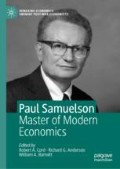Abstract
This memoir presents some extracts from the correspondence and conversations between Paul Samuelson and me about topics in economic theory over a period of fifty-three years. It is an informal intellectual biography, not a research paper. It is of interest because it presents previously unpublished comments that Samuelson made on major questions that arose in the course of the development of economic theory during his lifetime. His letters illuminate those questions with scientific analyses and enliven his treatment of them with frank expression of opinions about the work and personalities of many leading economists. The memoir also reveals the personal qualities that he had to an extraordinary degree: steadfastness of friendship, intellectual integrity, graciousness, receptivity, and generosity.
Access this chapter
Tax calculation will be finalised at checkout
Purchases are for personal use only
Notes
- 1.
Samuelson’s letters and copies of mine are in my possession. My letters and copies of Samuelson’s are in the Duke University David M. Rubenstein Rare Book & Manuscript Library. The archived papers do not include some of my early letters to him because he wrote his reply on them and sent them back to me. The archives do not include the other autograph notes and autograph letters that he sent to me, nor transcripts of our conversations. As with my other chapter included in this volume, the letters to me from Samuelson are documented by the date of his letter, without writing “PAS to DAW.” When my letters to him are quoted or cited, they are referenced as “DAW to PAS” followed by their date.
- 2.
See my “Some Correspondence with Paul Samuelson on the History of Economic Thought: An Intimate Memoir,” in the current volume.
- 3.
This appeared in an English translation in Heckscher and Ohlin (1991).
- 4.
Journal of the History of Economic Thought, the journal of the History of Economics Society.
- 5.
The brackets and the words inside them are Samuelson’s.
- 6.
For a correction of the notions about the behavior of the French securities markets expressed by Keynes and Kregel, among a host of others, see Walker (2001). I sent Samuelson an off-print of that article, which, I think, he did not read.
- 7.
See my other essay in the current volume.
- 8.
On page 269 of my Walras’s Market Models, this analysis is scrambled by a printer’s error that omitted a crucial part of my sentence, making it say the opposite of what Walras wrote, but the extensive references cited at the end of the sentence on that page are correct and there are many correct presentations of Walras’s ideas on that issue in that book. For example, in disequilibrium “the average cost of that capital good is appreciably increased or decreased” as output is increased or decreased thereby raising or lowering input prices (Walras 1877: 297 and passim).
- 9.
Samuelson’s other comments to me on Chamberlin’s work are chronicled in my other chapter in the current volume.
- 10.
In Walker (1989).
- 11.
Samuelson probably meant to write “1848.”
- 12.
See my other chapter in the current volume.
- 13.
I know how he felt. I was a Harvard University Fellow of Faculty of Arts and Sciences, 1956–1957, and a Henry Lee Memorial Fellow, 1957–1958.
- 14.
He was fortunate, in his later years, to have the help of Erkko Etula, a talented computer programmer.
- 15.
See Samuelson (1948: Chapter 12, and specifically for investment shifts, p. 267).
- 16.
See the title page of Samuelson’s Foundations of Economic Analysis.
References
Arrow, K.J. and F.H. Hahn (1971) General Competitive Analysis. San Francisco, Holden-Day.
Debreu, G. (1959) Theory of Value: An Axiomatic Analysis of Economic Equilibrium. Monograph 17, Cowles Foundation. New York, Wiley.
Fase, M.M.G., W. Kanning and D.A. Walker (eds.) (1999) Economics, Welfare Policy, and the History of Economic Thought: Essays in Honor of Arnold Heertje. Cheltenham, UK, Edward Elgar.
Heckscher, E.F. and B. Ohlin (1991) Heckscher-Ohlin Trade Theory. Edited by H. Flam and M.J. Flanders. Cambridge, MA, The MIT Press.
Ingrao, B. and G. Israel (1990) The Invisible Hand: Economic Equilibrium in the History of Science. Cambridge, MA, The MIT Press. Original Italian version, 1987.
Morgenstern, O. (1972) “Thirteen Critical Points in Contemporary Economic Theory: An Interpretation,” Journal of Economic Literature, 10: 1163–1189.
Samuelson, P.A. (1948) Economics. New York, McGraw-Hill.
Samuelson, P.A. (1972) “Maximum Principles in Analytical Economics,” American Economic Review, 62: 249–262. Nobel Memorial Lecture. Reprinted in The Collected Scientific Papers of Paul A. Samuelson, Volume 3 (1972). Cambridge, MA, The MIT Press: 2–17.
Samuelson, P.A., D. Patinkin and M. Blaug (1991) “On the Historiography of Economics: A Correspondence,” Journal of the History of Economic Thought, 13: 144–158.
Walker, D.A. (1980) “Review of Walras’ Economics: A Pure Theory of Capital and Money, by M. Morishima,” History of Political Economy, 12: 131–135.
Walker, D.A. (ed.) (1984) Money and Markets: Essays by Robert W. Clower. Cambridge, UK, Cambridge University Press.
Walker, D.A. (1989) “Monopolistic Competition: An American Contribution,” Storia del Pensiero Economico, 16: 3–9.
Walker, D.A. (1997) Advances in General Equilibrium Theory. The Hennipman Lectures. Cheltenham, UK, Edward Elgar.
Walker, D.A. (2001) “A Factual Account of the Functioning of the Nineteenth-Century Paris Bourse,” European Journal of the History of Economic Thought, 8: 186–207.
Walras, L. (1877) Éléments d’Économie Politique Pure. Lausanne, Corbaz.
Walras, L. (2014) Elements of Theoretical Economics, or The Theory of Social Wealth. Third edition, 1896, translated and edited by D.A. Walker and J. van Daal. Cambridge, UK, Cambridge University Press.
Author information
Authors and Affiliations
Corresponding author
Editor information
Editors and Affiliations
Copyright information
© 2019 The Author(s)
About this chapter
Cite this chapter
Walker, D.A. (2019). Some Correspondence with Paul Samuelson on Economic Theory: An Intimate Memoir. In: Cord, R., Anderson, R., Barnett, W. (eds) Paul Samuelson. Remaking Economics: Eminent Post-War Economists. Palgrave Macmillan, London. https://doi.org/10.1057/978-1-137-56812-0_6
Download citation
DOI: https://doi.org/10.1057/978-1-137-56812-0_6
Published:
Publisher Name: Palgrave Macmillan, London
Print ISBN: 978-1-137-56811-3
Online ISBN: 978-1-137-56812-0
eBook Packages: Economics and FinanceEconomics and Finance (R0)

